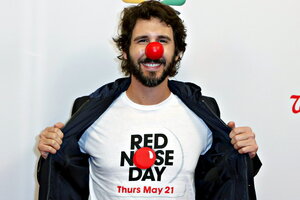Giving is way up, but for what reason?
An unexpected rebound in giving in the US so soon after the recession is attributed to a healthier economy. But one study finds other, less material motives for generosity.

Musician Josh Groban attends the Red Nose Charity event in New York May 21..
REUTERS
A new survey of charitable donations in the United States finds that giving is taking off. Total philanthropy rose 5.4 percent in 2014, a big jump in any year. But the high level of giving was unexpected by most experts, coming so soon after a steep decline during the recent Great Recession.
The recovery in donations was the strongest of any period after a recession in the past 40 years, according to Indiana University’s Lilly Family School of Philanthropy, which conducts the annual study known as Giving USA. And total giving in 2014 set a record at $358.4 billion. Giving has risen nearly sixfold over the past six decades (after taking inflation into account).
The report claims this latest good news is “indicative of a healthier economy.” Perhaps. More Americans do have a greater amount of disposable income to share than they did a few years ago. But researchers have lately begun to probe people’s motives for magnanimity. Some ascribe it to evolution and genes. Others cite changing social pressures, such as a rise or fall in religious faith. (The survey finds religious giving as a percentage of total gifts has dropped from 56 percent three decades ago to 33 percent in recent years.)
Notre Dame sociologist Christian Smith, coauthor of the recent book “The Paradox of Generosity,” notes that scholars have yet to prove that altruistic acts come from selfish motives, such as the paradoxical expression “to give is to receive.” Based on a survey of thousands of Americans, Dr. Smith finds that “humans are not just rational egoists out to maximize their own prestige, power, or wealth.”
Rather, he finds generosity depends to a large degree on a person’s perception of “living in a world of abundance, blessing, gratitude, enjoyment, security, and sharing.” Those that see the world as a threat or full of scarcity give less even though they have a similar financial ability to give, according to their survey.
What does he suggest can help increase giving, either in money, time, skills, or relationships?
Yes, donors need timely reminders to give and they give more when they see the fruits of their charity. Social pressure helps, too. But he writes that American culture needs to stop pounding home a message of scarcity, discontent, and insecurity.
“[R]eal generosity requires learning something different, something that may not feel natural for many people. It often requires real personal change. A better understanding of how generosity works can aid that learning and change.”
In other words, those that give tend to see themselves as already blessed, rather than rely on being blessed by giving. Perhaps coming surveys by Giving USA might want to ask if Americans are acting on that basis instead of a healthier economy.

